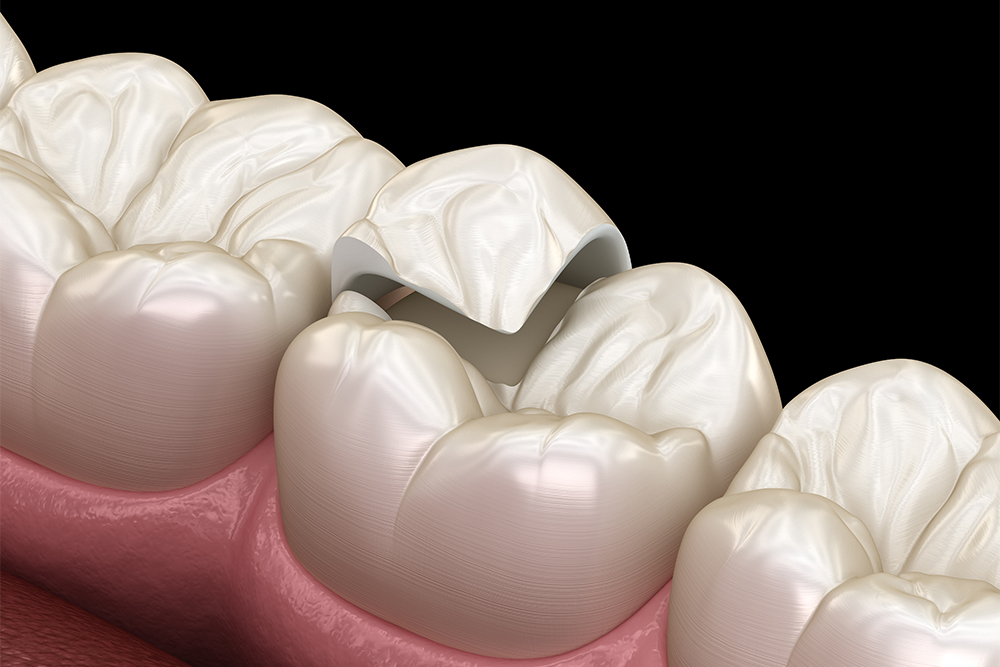Onlays and Inlays

Tooth Restoration
Inlays and onlays are types of dental restoration. They can be used for cosmetic improvements, but typically offer a medical purpose as well. Instead of filling a damaged or cavity-ridden tooth, some dentists offer the service of dental inlays or onlays. As their names might suggest, inlays are bonded with the inner portion of the tooth, whereas an onlay covers the entire upper surface. As opposed to crowns, which are placed over the entire tooth, these dental alternatives preserve the portions of the tooth that is still healthy.
Beautifully Balanced
Inlays and onlays provide more comfort and natural feel, maintain the look of the tooth, are unlikely to discolor over time, and allow normal teeth cleaning. When it comes to repairing a tooth, this type of procedure offers a seamless transition from the look, feel, and maintenance that you have become accustomed to. While these methods are typically thought of as being used only on the upper surface of the tooth, they can work just as well between the teeth, right down to the gum line. This provides protection against further bacterial damage and fills those gaps between teeth without fear of unsightly discoloration later.
Over time the materials used by top cosmetic dentists such as Dr. Dena, DDS for inlays and onlays have changed slightly, but always for the best. Today, the composite or porcelain material used is a very close match to the natural tooth. An experienced dentist can make them nearly imperceptible to the naked eye, which is exactly why so many individuals are willing to choose this procedure.
Onlay Restoration in Encinitas
An onlay restoration is a custom-made filling made of composite material, gold, or tooth-colored porcelain. Porcelain onlays are popular because they resemble your natural tooth. An onlay is sometimes also referred to as a partial crown. Porcelain onlays are made by a professional dental laboratory and is permanently cemented onto the tooth by your dentist.
Onlays can be utilized to conservatively repair teeth that have large defective fillings or have been damaged by decay or trauma. Onlays are an ideal alternative to crowns (caps) because less tooth structure is removed in the preparation of onlays. Onlays are essentially identical to inlays with the exception that one or more of the chewing cusps have also been affected and need to be included in the restoration.
As with most dental restorations, onlays are not always permanent and may someday require replacement. They are highly durable and will last many years, giving you a beautiful long lasting smile.
Reasons for onlay restorations:
- Broken or fractured teeth.
- Cosmetic enhancement.
- Decayed teeth.
- Fractured fillings.
- Large fillings.
What does getting an onlay involve?
An onlay procedure usually requires two appointments. Your first appointment will include taking several highly accurate impressions (molds) that will be used to create your custom onlay and a temporary restoration.
While the tooth is numb, the dentist will remove any decay and/or old filling materials. The space will then be thoroughly cleaned and carefully prepared, shaping the surface to properly fit an onlay restoration. A temporary filling will be applied to protect the tooth while your onlay is made by a dental laboratory.
At your second appointment, your new onlay will be carefully and precisely cemented into place. A few adjustments may be necessary to ensure a proper fit and that your bite is comfortable.
You will receive care instruction at the conclusion of your treatment. Good oral hygiene practices, a proper diet, and regular dental visits will aid in the life of your new onlay.
What is an Inlay Restoration?
An inlay restoration is a custom-made filling made of composite material, gold, or tooth-colored porcelain. Porcelain inlays are popular because they resemble your natural tooth. A porcelain inlay is made by a professional dental laboratory and is permanently cemented into the tooth by your dentist.
Inlays can be utilized to conservatively repair teeth that have large defective fillings or have been damaged by decay or trauma. Inlays are an ideal alternative to conventional silver and composite fillings. Also, they are more conservative than crowns because less tooth structure is removed in the preparation of inlays.
As with most dental restorations, inlays are not always permanent and may someday require replacement. They are highly durable and will last many years, giving you a beautiful long lasting smile.
Reasons for inlay restorations:
- Broken or fractured teeth.
- Cosmetic enhancement.
- Decayed teeth.
- Fractured fillings.
- Large fillings.
What does getting an inlay involve?
An inlay procedure usually requires two appointments. Your first appointment will include taking several highly accurate impressions (molds) that will be used to create your custom inlay and a temporary restoration.
While the tooth is numb, the dentist will remove any decay and/or old filling materials. The space will then be thoroughly cleaned and carefully prepared, shaping the surface to properly fit an inlay restoration. A temporary filling will be applied to protect the tooth while your inlay is made by a dental laboratory.
At your second appointment, your new inlay will be carefully and precisely cemented into place. A few adjustments may be necessary to ensure a proper fit and that your bite is comfortable.
You will receive care instruction at the conclusion of your treatment. Good oral hygiene practices, a proper diet, and regular dental visits will aid in the life of your new inlay.
Call us to schedule your appointment with Dr. Dena today at (760) 943-7788



